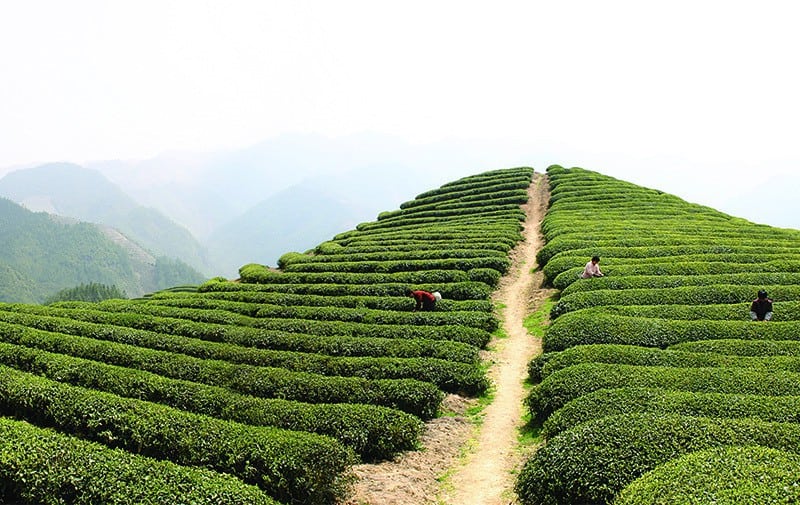
Every tea drinker knows that rich Devonshire cream and a fresh scone with full-bodied black tea is an ideal pairing. As are cream cheese–based tea sandwiches served with a Darjeeling or an Earl Grey. Few of us question why these tea and cheese flavors work so well together, yet we often stop there in exploring this category of satisfying tandem tastes.
Properly matched, tea and cheese offer complex and well-balanced flavors. The criteria used for cheese-tea pairings is virtually identical to those followed for serving cheese with wine—but without the need to balance acid levels or observe the “pair by region” guidelines (because the major tea-growing regions are not cheese-producing regions). As with wine, some teas are more versatile than others and are good to keep around for impromptu pairings.
Soft or mild creamy cheeses partner beautifully with green teas like Japanese Sencha or Chinese Dragon Well (Long Jing). The clean, fresh, vegetal tones of the tea, with hints of earthy sweetness, are a wonderful balance for the light, sweet creaminess of a fresh ricotta, mascarpone, or chèvre. In the same way that the high acidity of a Sauvignon Blanc cleanses the palate and prevents the adherence of fat from, say, a double- or triple-cream Brie, the crispness of a fresh green tea or the astringency of a First Flush Darjeeling also produces a “clean slate” and creates a wonderfully balanced textural pairing. Pu-erhs, too, pair smartly with high-fat cheeses by offering intense earthiness and a natural sweetness combined with that same ability to clean the palate.
Salty cheeses complement sweeter wines, and this principle also applies to tea. A mildly salty cheddar pairs nicely with a slightly sweet and floral Tung Ting oolong. The same cheese is also the ideal partner for a more robust, earthier, but still slightly sweet Keemun. The creaminess of a lightly salty chevre makes it a natural complement to green tea, but a sweeter floral or a fruity accompaniment like jasmine, oolong, or rose-scented tea also pairs well. For more intensely salty cheeses, like Stilton or Gorgonzola, the best tea is Earl Grey or another flavored, sweet and fruity tea.
Full-bodied, pungent cheeses like Stilton and Gorgonzola, which pair well with very full-bodied, tannic wines, can be tamed by a low-oxidation Pouchong with a sweet, lingering finish. Or the cheeses can be balanced with a very smoky Lapsang Souchong. It can be argued, in fact, that Lapsang Souchong works with virtually any cheese. Softer, milder white cheeses need a more delicate Lapsang; more dominant cheeses can stand up to an intensely smoky Lapsang, such as Hu-Kwa.
For the category of nutty cheeses—well-aged Gruyère, Comté, Gouda, Edam, or cheddar—the best teas to pair are those that have a similarly nutty, full flavor and significant tannin levels such as Keemun, Ceylon, or Autumnal Darjeeling. Surprisingly, Dragon Well green tea is also a sensational match with the same well-aged Gruyère or Comté, proving that pairing diverse attributes can be just as valid an approach as combining similar flavors. In the end, the rules of pairing tea and cheese are subjective. Steep for yourself.
Pairings
First Flush Darjeeling + Triple-Cream Explorateur
Castleton Estate First Flush was used in this pairing, but any aromatic, astringent Darjeeling will work. The citrus undertones of this Darjeeling are particularly beneficial, and its astringency helps to cleanse the tongue and prevent the richness of the cheese from dulling the palate.
Keemun Hao Ya A + Extra-Sharp Cheddar
For this pairing, McCadam New York Extra Sharp Cheddar was chosen; any good-quality extra-sharp will yield similar results. Keemun pairs well with a wide variety of cheeses, making it a great tea to serve at brunch. Its earthy richness and hints of cocoa and spice play off the sharp, rich, nutty tang of well-aged cheddar. Very satisfying, particularly in the finish.
Lapsang Souchong + Valdeon Spanish Blue
This pungent bad boy cheese takes over against most teas (or wines), but an intensely smoky Lapsang Souchong like Hu-Kwa presents a remarkable counterpoint.
Lung Ching Dragon Well + Aged Raw-Milk Gruyère
This lightly sweet, clean, and slightly nutty Chinese green tea has enough astringency to balance the dairy fat and enough sweetness to balance the salt. It also plays up the wonderful nuttiness of a well-aged Gruyère.
Tea-Infused White Port + Shropshire Blue
This tea-flavored port is ideal with any full-bodied salty, cheese, but the pairing with Shropshire Blue is particularly inspired.
Recipe: Infused White Port with Black Tea, Ginger, and Lychee
When Boston Park Plaza Hotel served afternoon tea, this tea-infused port was on the cocktail menu.
1 liter white port (such as Dows Fine White Porto)
¼ cup lychee fruit, roughly chopped
4 quarter-sized slices fresh ginger
½ cup dry Chinese Congou black tea
2 tablespoons candied ginger, roughly chopped
Place port in a nonreactive container with the lychee and fresh ginger. Steep at room temperature for about 20 minutes. Add tea. Continue steeping for another 20 minutes, until it reaches the desired concentration. Strain well, using multiple layers of cheesecloth or coffee filters until clear. Store at room temperature. Garnish each serving with a small chunk of candied ginger.
NOTE: If you take the time to strain the port very well, it will have an excellent shelf life. If no fruit or tea residue remains, it will keep for at least three weeks. Otherwise, it will begin to spoil within several days.




